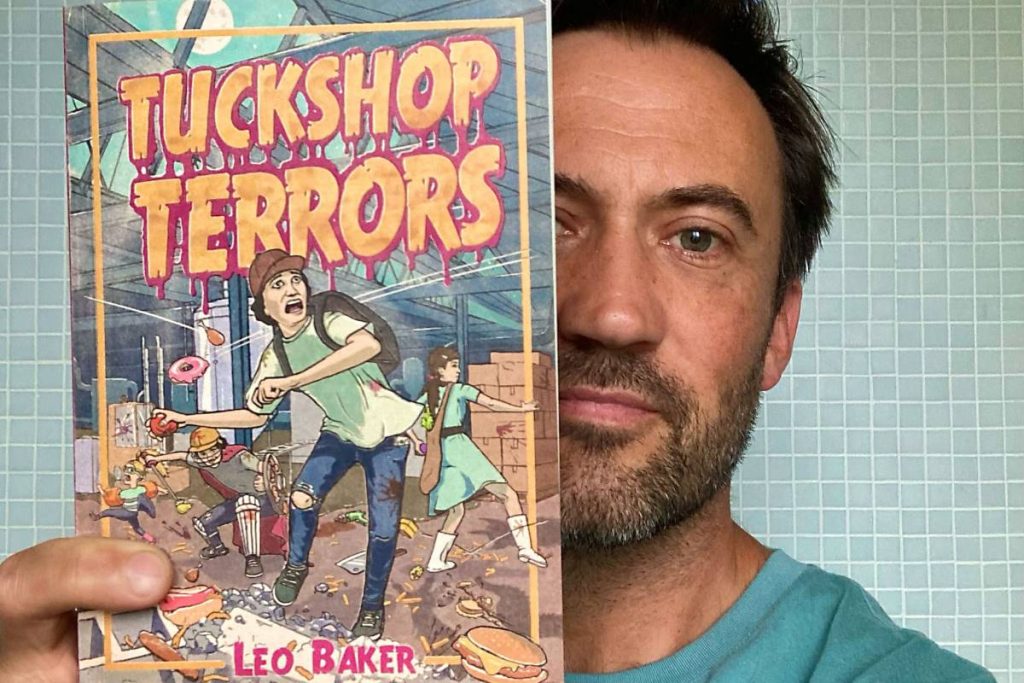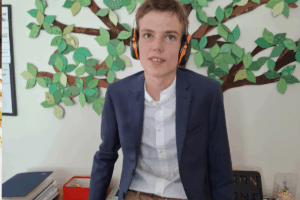In the bustling world of Tuckshop Terrors, Kip is a twelve-year-old boy navigating the choppy waters of a new school, armed only with his homemade lunches and a hefty dose of determination. It’s not easy being the new kid, especially when managing diabetes sets him apart from his peers who feast on canteen treats. Kip’s story, infused with elements of friendship, mystery, and resilience, takes a dark twist as he, along with his new friends Reggie and Lucille, uncover a sinister plot by the headmaster, Rinkley, who’s secretly the president of a corporation testing mind-controlling junk food on unsuspecting students.
The tale quickly escalates when the town fete, sponsored by the malevolent Good Taste corporation, turns into a nightmare. Adults are rendered comatose, and children morph into monsters after gorging on the corporation’s tainted treats. Amidst the chaos, Kip, Lucille, and Kip’s sister Minnie must race against time to save their community. Leo Baker, an accomplished storyteller with a rich background in animation, brings this exciting adventure to life, blending themes of friendship, empowerment, and the perils of corporate greed. Join us as we explore the inspirations and messages behind this engaging tale with Leo Baker himself.
Kip struggles to fit in at his new school while managing his diabetes. What inspired you to create a protagonist with both these challenges?
When I was growing up, I found the first day back at school always a little nerve-wracking. I had also attended some schools overseas when my dad was travelling for work. I knew what being the new kid without any friends yet felt like, and I decided this was a good way to commence Kip’s story. Kip’s secret of his recent diagnosis of diabetes, added an extra element of complexity to his desire to fit in. Especially when it meant his diet had to be controlled, and he wasn’t allowed to eat the glorious canteen food like the other kids.
The book explores the idea of “food as a social currency.” Can you elaborate on this concept and how it plays out in the story?
Kids burn energy and need refuelling! When I was at school, I was always starving by lunchtime. I remember there were kids who regularly ate delicious junk food, or tuckshop orders that were the supreme envy of other kids. The smell of hot pies with sauce on a cold day, or a bag of artificially flavoured chippies would attract friends like seagulls. I feel we can all get food envy of others at times. But at this young age, in the confines of the school yard, tasty food was the key attracter of attention, and a commodity for bartering – becoming like a social currency of kids!
Bullying is a prevalent theme. How does Kip overcome this challenge, and what message do you hope young readers take away?
Bullies can be tough to navigate. Standing up for yourself or even avoiding confrontation can be tricky. Kip gets caught out and tricked by the bullies, which inadvertently pits him against the character Jesse, a boy who has his own struggles with bullying and fitting-in. Both Kip and Jesse are defensive and eager for acceptance, yet they get off to a wrong start and alienate themselves from one another. I think a key message here is people are not always who they seem, and being led to be mean to others never results in a good outcome.
Tuckshop Terrors celebrates the power of children and those who are different. Can you talk about the importance of these messages in your work?
We are all different and unique. I feel that these days with social media, everyone feels pressure to model themselves off how others are living their lives. Kip tries to fit in and be like the others, but realises that being different to the rest ends up being a key advantage for their survival and triumph. I think, as a creative person, life can be challenging when in pursuit of new creative ideas or expression. Sometimes the world offers nothing but resistance to things that are different, which can be stifling. It is exciting and liberating when you become brave enough to be yourself and pursue your own path. I have found that this honesty ultimately finds a positive response from others. I wanted to express this in Kip’s character.
Your background is in animation. Did this influence the creativity and pacing of the story?
Yes, certainly for visualising the settings in the written form. I enjoyed being able to use descriptive writing to define the world and the action taking place. Also, for letting my imagination run wild in a completely unrestrained fictional sense! A background in animation and film did assist with adding some comical moments and the pacing of some of the more action-packed scenes. My main objective was to effectively communicate the picture I had in my mind to guide the reader through the adventure.
The book includes “multicultural values.” Can you share some examples of how this is woven into the narrative?
Growing up in Melbourne, Australia, the culture of the city is defined by the migrants who have settled here, especially through their food. So, in writing a book centred around food, I wanted to show how this mattered to characters from different cultural backgrounds. Lucille’s Nonna has these incredible homemade Italian recipes, which she makes for Lucille’s lunch. But we learn that this is also an expression of love and care from her Nonna, above just organic nutrition. Likewise, the Yugoslavian school nurse, Vera, has her traditionally made strudel as a delicious comfort for injured students. Reggie also has his mother’s Vietnamese food, but he’s too much of a tuckshop terror to appreciate its significance!
With a background in animation, did you ever consider adapting Tuckshop Terrors into an animated film?
Yes! The idea was originally intended to be an animated film. But my approach to assembling the story changed when I realised it could sit in development as a screenplay for many years before audiences could experience it. I also didn’t want any cost-saving in development whittling away any of the fictional concepts.
Writing the story as a novel meant the only dependencies were getting it written, and getting it published. Both were aspects which I could have control over. The most important thing was being able to get the audience to experience my ideas. I felt writing this as a novel was the most direct route. Then, once this story has been experienced, it may prove to be easier to adapt to the screen. But rather than an animation, I’m thinking maybe as a live action idea, supplemented with visual effects! Watch this space!
For more information:






